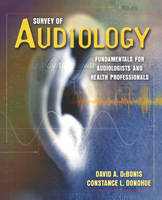
Survey of Audiology
Pearson (Verlag)
978-0-205-33839-9 (ISBN)
- Titel erscheint in neuer Auflage
- Artikel merken
This text specifically addresses the importance of audiology knowledge for the scope of practice in both speech-language pathology and audiology. This text is written to be a resource for the student of audiology and speech-language pathology long after the course is completed.
Each chapter begins with “Introduction.”
1. Audiology as a Scientific, Collaborative, and Humanistic Discipline.
Audiology as a Humanistic Discipline.
Recommendations for the Future.
2. Acoustics of Sound and Preliminary Clinical Application.
What Is Sound?
Units of Measure.
Application of Acoustic Concepts.
Fundamental Pathways of Sound.
Environmental Acoustics.
3. Anatomy and Physiology of the Auditory System.
Anatomy and Physiology of the Peripheral Auditory System.
Anatomy and Physiology of the Central Auditory System.
4. Pure Tone Testing.
The Audiometer.
Calibration.
Pure Tone Testing.
Masking.
Potential Pitfalls in Pure Tone Testing.
5. Speech Audiometry.
Contributions of Speech Audiometry.
Speech Audiometry Tests.
Most Comfortable Level/Loudness Discomfort Level.
Speech in Noise Testing.
Sentence Tests.
6. Physiologic Assessment.
Immittance Audiometry.
Auditory Evoked Potentials.
Otoacoustic Emissions.
7. Disorders of the Auditory System.
Selected Conditions That May Affect the Outer Ear.
Selected Conditions That May Affect the Middle Ear.
Selected Conditions That May Affect the Inner Ear.
Selected Conditions That May Affect the Central Auditory System.
8. Pediatric Testing and Management.
Components of Auditory System Development.
Speech and Language Development in Early Childhood.
General Principles of Pediatric Audiological Assessment.
Client-Specific Protocols for Audiological Assessment of Young Children.
Current Issues in Pediatric Audiology.
9. Assessment and Management of Other Special Populations.
The Elderly.
Individuals Who Are Deaf.
Adults with Developmental Disabilities.
Neurogenic Communication Disorders.
Non-Organic Hearing Loss.
10. Auditory Processing Disorders.
The Nature and Development of Tests of Auditory Processing.
Referral for Auditory Processing Evaluation.
Auditory Processing Assessment.
Common Questions Regarding Management of Auditory Processing Disorders.
11. Screenings.
General Screening Components
Testing Protocols Across the Lifespan.
12. Helping Individuals with Hearing Loss.
Model of Aural Rehabilitation.
Audiological Assessment.
Treatment Planning.
Hearing Aid Selection.
Current Technology.
Verification.
Validation.
Special Considerations for Challenging Fittings.
Hearing Aid Orientation.
Assistive Devices.
Improving Classroom Listening.
Prevention.
Multicultural Issues.
Counseling.
Sample Cases.
| Erscheint lt. Verlag | 23.2.2004 |
|---|---|
| Sprache | englisch |
| Maße | 300 x 200 mm |
| Gewicht | 875 g |
| Themenwelt | Medizin / Pharmazie ► Gesundheitsfachberufe ► Logopädie |
| Medizin / Pharmazie ► Medizinische Fachgebiete ► HNO-Heilkunde | |
| ISBN-10 | 0-205-33839-9 / 0205338399 |
| ISBN-13 | 978-0-205-33839-9 / 9780205338399 |
| Zustand | Neuware |
| Haben Sie eine Frage zum Produkt? |
aus dem Bereich



